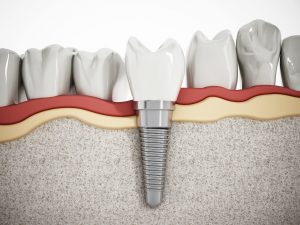 For so long you suffered from missing teeth. Not only did you have to make adjustments in the way you lived your life, but you also lost a great deal of confidence. So when you were fortunate enough to receive dental implants, you experienced a revival in your outlook on life. Once again you tasted the flavors you loved and smiled with pride. But now all of that seems to be threatened because your implants are showing signs of wear and tear. Unfortunately, it’s just a fact of life that things become worn and sometimes fail, but don’t fret – there’s help for you. Your dentist will explain what causes this and how your fixtures can be restored.
For so long you suffered from missing teeth. Not only did you have to make adjustments in the way you lived your life, but you also lost a great deal of confidence. So when you were fortunate enough to receive dental implants, you experienced a revival in your outlook on life. Once again you tasted the flavors you loved and smiled with pride. But now all of that seems to be threatened because your implants are showing signs of wear and tear. Unfortunately, it’s just a fact of life that things become worn and sometimes fail, but don’t fret – there’s help for you. Your dentist will explain what causes this and how your fixtures can be restored.
What Causes Implants to Fail?
There are two basic categories to put implant failure into – those that occur early and late. Here are the differences between the two:
- Early Implant Failures – In an early failure, there’s a greater chance of the problem stemming from a technique error. For example, the bone may have overheated during the site preparation (drilling into the jawbone). Still, there are other missteps that may have occurred, such as applying too much torque when fastening the implant, contamination of the post or an improperly placed temporary fixture.
- Late Implant Failures – Signs of a late failure include a wobbly, loose or dislodged implant. This problem usually stems from improper pressure due to a shifting bite or changes in the height of your upper and lower jawbones. Another culprit can be basic wear and tear.
How Can Your Surgically Inserted Posts be Restored?
The first step is to contact your dentist to have your implant examined so that he can determine what is the reason for the failure. In cases where there is a break in post, the dentist may be able to apply a bond. For other situations, the only option may be replacement.
If so, here are the basic steps:
- Your dentist will first surgically remove the post.
- He will then thoroughly clean the area to guard against any contamination.
- After a period of healing, you will then return for an examination to determine whether you can tolerate the implant procedure again.
- If everything is in good order, your dentist will move forward in placing a new post.
Keep in mind that dental implant procedures have up to a 95 percent success rate, so it’s very rare for them to fail, but if you’re one of the unfortunate five percent, don’t panic. Reach out to your implant dentist immediately to get the help that you need.
About the Author
Dr. Jayson Voto earned his Doctor of Dental Surgery degree from the University of Oklahoma College of Dentistry. He still has the same passion for helping patients today as he did when he first graduated, staying abreast of the latest advancements in the field of dentistry through continuing education. Dr. Voto provides expert and compassionate care from Drake & Voto Family and Cosmetic Dentistry and can be reached for more information through his website.
